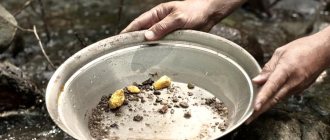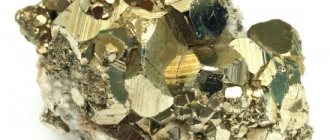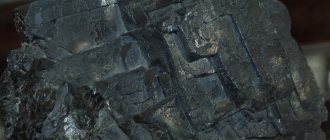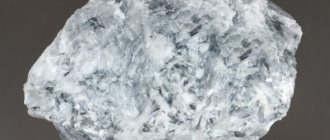The stone pyrite, or as it is also called, “fool’s gold,” is now quite famous. It was discovered back in Ancient Egypt, and it is still popular. Pyrite is a mineral that closely resembles gold in appearance, usually golden yellow in color, but this is only in appearance. The stone itself is very hard, much harder than gold itself. Crystals of this are usually found in the form of a cube, sometimes in an octagonal shape.
Fool's gold mineral pyrite - the beginning of a legend
Pyrite was often confused with gold, due to its great similarity in color, and also because this mineral was usually found next to gold. Pyrite deposits were discovered by the Indians, not far from the gold veins. When the famous “Gold Rush” began, many gold miners brought home pyrite under the guise of gold.
The peak of fashion for pyrite was in the seventeenth century in Europe. This stone was used to imitate diamonds and was inserted into jewelry made of gold and silver. It was also popular during the Napoleonic War. Products made from this stone were given to ladies who donated their precious jewelry to the needs of the war. Women liked such jewelry, but with the end of the war the fashion stopped.
Well, with the beginning of the twentieth century, inserts began to be made from raw pyrite along with other precious stones. Due to its low cost and bright appearance, this mineral is still widely used today.
History and origin of the breed
Pyrite is formed as a result of the interaction of hydrogen sulfide vapor with iron-containing compounds. This occurs in hot magmatic springs or when magma comes into contact with sedimentary rocks.
A lot of the mineral is formed at the bottom of reservoirs. In conditions of lack of oxygen, organic substances decompose with the formation of hydrogen sulfide. The gas reacts with sulfides contained in the water. As a result, a layer of precipitated mineral forms at the bottom.
The first mentions of the stone were recorded in Ancient Egypt. Pyrite was valued and revered. Jewelry was made from it and used to decorate outfits. The gem gained great popularity in the 13th–14th centuries in America. Indigenous people mined the mineral and decorated their clothes or weapons with it.
The peak of pyrite production occurred during the gold rush.
Everyone who was capable of physical labor tried to find gold. Due to their hue and bright luster, pyrite nuggets were often mistaken for a precious metal. In this regard, the gem was actively imported to Europe. The stone was liked by collectors and fashionistas. They were inlaid with gold or silver jewelry.
During the war with Napoleon, pyrite became a symbol of sacrifice and kindness. Women who donated their jewelry for military purposes were given items with crystals. The ladies wore these gifts with pleasure and pride.
Later, the popularity of pyrite began to decline. Due to its fragility, the stone was rarely used in jewelry.
Large pyrite deposits
Mining pyrite is a fairly inexpensive business, since it is located next to other, usually more valuable metals, and there is no need to mine it separately. Pyrite deposits are located all over the world, but the largest are in Russia, the USA, and Sweden. It is also mined in Azerbaijan, Spain, and Norway. But the most interesting and valuable samples are supplied only by Italy.
Firestone deposits
Iron disulfide is widespread in the earth's interior, and among sulfides it ranks first.
This is one of the main ores for the production of cobalt, gold, thallium, and selenium.
But, of course, we are interested in whether it is possible to make jewelry from fire stone. Can. But not all, not any. But collectible druses and pyrite crystals are in demand among mineral lovers.
Firestone is mined in many places on the planet. This:
- Afghanistan;
- Kazakhstan;
- Spain;
- Finland;
- Mexico;
- Poland;
- USA;
- China. The list goes on...
Large Russian pyrite deposits:
- Irkutsk region;
- Karachay-Cherkessia;
- Moscow region;
- Karelia;
- Krasnoyarsk region;
- Primorsky Krai. It’s difficult to list everything.
You can find crystalline collectible pyrite in the Urals. Interesting samples are brought from Peru, Azerbaijan, Congo, Austria, and Italy.
The mineral often forms pseudomorphs from petrified wood, ammonites, and other organic remains. Such specimens would be the pride of collectors if they were kept for a long time. But alpine diamond decomposes in air, and this process cannot be stopped, only slowed down. To do this, it is boiled in paraffin, in rosin, soaked in vegetable oil, varnished... Storage in a vacuum display case is not cheap.
Physico-chemical properties of pyrite
The chemical formula of pyrite is FeS2. The stone is opaque, it has a beautiful metallic luster, and a bright golden yellow color. According to the Mohs scale, the hardness of this mineral is 6-6.5, and the density is 5.0-5.25 g/cm3. The cleavage of pyrite (i.e., the ability of the mineral to split and during this splitting to obtain smooth surfaces) is not ideal, the fracture is uneven. This mineral is also a poor conductor of electricity.
Hydrochloric acid has no effect on it, but it dissolves in nitric acid. Pyrite must be kept away from water, because of it it can quickly rust, and if it is kept in water for several years, it will completely crumble. This mineral is almost non-magnetic. Sometimes it contains impurities of gold, selenium, silver, cobalt, zinc, copper, and arsenic. Very often you come across samples of golden, dark yellow, and light golden color. The difference in color is due to impurities of other minerals: copper, nickel, gold, cobalt.
How much is jester's gold worth?
The cost of the figurines depends, of course, on the fineness of the work, the price of the frame, the size of the figurines and how highly the master values his work.
- A 1x1 cm cube of pyrite sells for 90 to 120 rubles.
- Pyrite beads will cost 2,000-3,500 rubles.
- Balls on a stand (feng shui experts place them in the wealth sector - the southeastern part of the room) are valued depending on their size. The smallest one will cost 2,500 rubles. If you want more, no problem. Question of money.
- They sell elephants and money frogs to attract good luck, wealth and other joys of life. A cute elephant (10x8x5 cm) can be purchased for 12,000 rubles.
- Collectors will appreciate the polished, processed section of a pyritized ammonite. A rather large exhibit, 28x25x3.5 cm, costs about 30,000 rubles.
Unprocessed pyrite is sold at a price of 0.01-0.2 US$ per gram.
Is it worth counterfeiting pyrite?
Yes, “fool’s gold” is also counterfeited. In the most primitive way - plastic or coated glass - here you have that “gold”. No need to process fragile stone. And the prices for fakes are simply shameless. A thread of glass or plastic that imitates pyrite will sell for 600-700 instead of a hundred rubles.
It's easy to spot a fake. Look at the light - real iron disulfide is always opaque. You can run your fingernail over the surface of the product. The coating is always thin, and if a scratch is formed, this means that they are “making a fool” of you.
Common Varieties of Fool's Gold
Some of the most common varieties of pyrite are bravoite, chalcopyrite and marcasite.
- Bravoite - it contains a small proportion of nickel, which is why it has a pale golden color and a beautiful shiny surface. Bravoite also has a metallic sheen and sharp edges of regular shape. Due to the fact that the nickel content in bravoite reaches up to 20%, it is considered to be nickel ore.
- Chalcopyrite - also called copper pyrite, has a large proportion of copper in its composition. Its color is already brighter, sometimes even more reddish. It is not very common in industry as it is very fragile.
- Marcasite (or rainbow mineral) – it contains cobalt, thallium, and lead. Although it is fragile and short-lived, this mineral is highly prized by jewelers. Unlike pyrite, marcasite does not form large crystals; it appears as finely crystalline masses. The color of marcasite is very beautiful, iridescent. Due to its special structure, this mineral can be cast in all sorts of, almost any colors.
Geography stories
Columbus, during his first expedition in search of water supplies, came across a certain Yaqui River. Either the Indians laughed at the admiral’s ignorance, or he himself stumbled upon “gold” placers.
He discovered that “the sand at the mouth of the river ... contains a lot of gold, although small, and suggested that the gold grains were crushed along the way from the headwaters to the mouth, and that upstream ... pieces of gold the size of lentils would be found. But there was a huge amount of small gold here.”
The admiral understood little about mineralogy and mistook pyrite placers for gold.
The pyrite gold of the Incas caused pyrite to be contemptuously called “fool’s gold.” They, of course, in this case were the Spaniards.
XVI century, rampant piracy and privateering in the West Indies. Famous pirate captains - Drake, Morgan, Kidd - and stories about disappeared treasures of gold. Treasures of gold buried by pirates could disappear. The pirates were brave guys, but for the most part they were uneducated. They could not distinguish silver from platinum and gold from pyrite. It looks like gold, which means it is. That’s why they buried pyrite instead of gold, but over time it simply turned into goethite or limonite. Real gold, of course, never disappeared.
During the Gold Rush (Alaska), gold was also confused with a mineral similar to it. Jack London wrote about this.
Shiny, golden stones were not ignored by jewelers.
While Napoleon was at war, patriotic women donated their jewelry “for victory” and in return received jewelry made from “fool’s gold.”
Your name, mineral!
The mineral received its current name from the Greek language. "Pyrites lithos" - fire stone. By hitting a piece of pyrite with metal or silicon, you will get a shower of sparks. By the way, for many centuries, pyrite worked for the benefit of people - it helped make fire. Pyrite was used as a lighter or matches.
Pyrite had other names. At different times his names were:
- health stone;
- alpine diamond;
- Inca stone;
- fools' gold;
- cat gold;
- sulfur pyrite;
- iron pyrite.
- In English, pyrite is fool's gold.
For mineral lovers: cat gold is also called one of the varieties of biotite - bauerite. The bronze-colored flakes of this mica can easily be mistaken for gold. Although it’s easy to check - a flake of gold will crumple under pressure, bauerite will break and crumble.
We recommend: Transformations of AZURITE STONE
Healing properties of pyrite
It has long been believed that pyrite has a beneficial, healing effect on humans. Due to the strong energy that this mineral has, it can favorably influence the human biofield. Pyrite is even used to make talismans and amulets that help in the fight against depression and depression. It is especially recommended for: those who suffer from insomnia, pregnant and nursing mothers, people with venous diseases and problems with the circulatory system, those with weakened immunity, asthmatics, and for the prevention of colds.
With constant contact of pyrite with the skin, self-confidence and fortitude appear, it strengthens in making important decisions, relieves the mind of obsessive and dark thoughts, and restores calm and clarity of mind.
Magic properties
Practicing sorcerers and magicians claim that the stone is able to restore their energy after various magical rituals, and that in those who achieved harmony with pyrite, it awakened a desire for the high, spiritual. Such owners gained the ability for self-development, as he saved them from laziness, anxiety and doubt.
It is also believed that pyrite attracts cash flows and makes it easier to find new ways to make money, or even start your own business. Pyrite also has a beneficial effect on family relationships. He is able to bring romance back into relationships and help in family matters. Products made from pyrite protect the house from enemies and save the owner from danger.
But this stone will faithfully serve and help only people with pure thoughts. Pyrite does not like evil, vile and hypocritical people; it can begin to “harm” such people, and instead of having healing properties, it will act negatively.
Talismans and amulets
Pyrite bracelet
Pyrite is a unique amulet for people whose professions involve risk to life. These are firefighters, construction workers, and military personnel.
Talismans made from the mineral will protect them from danger. It is also recommended to be worn by those associated with the law. The stone will help you make fair decisions.
A mineral amulet will protect the house from enemies and ill-wishers. In love magic, a pyrite talisman can attract love and rekindle faded feelings.
Practicing magicians use the stone as an energy restorer after magical sessions, and also use it to make deals with evil spirits.
Who is pyrite best suited for?
Jewelry made from pyrite can be worn by almost everyone. It will have a good effect on the entire body. A man who wears pyrite products becomes confident in himself, and women begin to be attracted to him. But this stone is for those who like serious long-term relationships, and not for lovers of short-term hobbies. It’s also much easier for girls to find their man with the help of pyrite.
Nature of the mineral
Pyrite jewelry.
Photo: Koktebel Workshop All pyrites by their nature are pyrites - minerals of the sulfide group. And there are a huge variety of them. However, since the Middle Ages, the term “marcasitae” - “marcasite” - has been applied to all pyrites. In France, from the end of the 18th century, the name “marcasite” was assigned to all jewelry with cut pyrite inserts.
Advertising - Continued below
Only in 1845, the Austrian mineralogist Wilhelm von Heidinger brought clarity to the definition of varieties of pyrites, based on which two independent minerals were identified: pyrite and marcasite. The scientist proved that the minerals have the same chemical composition and external similarity, but differ in structure: pyrite crystals are cubic in shape, while marcasite crystals are radiant.
The influence of pyrite on zodiac signs
Aries from envy and deception, improve things at work, and generally influence life in a positive way, making it more pleasant and brighter. It will help you overcome failures and begin to strive for self-improvement.
For Leos, the stone will help improve family life and renew passion between spouses. The Leo man will receive a boost of energy, and the woman will feel beautiful and desirable again.
For Sagittarius, the stone will help them find spiritual harmony, understand themselves, and find their right path in life.
For Taurus , the mineral will help channel their violent energy in the right direction, gain financial stability, and improve relationships with people. It will also help in finding your other half.
For Gemini, the stone will help them become more reasonable, increase their concentration, and be more collected.
Cancers are not recommended to wear items made of pyrite, since the stone conflicts with water signs and the energy of the stone is not suitable for them.
Fish . For men, pyrite will be magically useless, but for girls it will help them find a husband, find family happiness, and become more collected.
For Aquarius, the stone will be useless, but it will not do any harm.
for Virgos to wear pyrite all the time. It's better to just keep it at home, taking it out only occasionally.
For Capricorns, the mineral will help improve their financial and personal situation and unlock their potential.
Scorpio will be protected from damage and evil.
Libra is recommended to wear pyrite as an amulet constantly. He will protect them from rash decisions and protect them from danger.
Compatibility with other stones
Pyrite does not tolerate proximity to other natural and synthetic stones. In a box or jewelry, it “gets along” only with hematite, serpentine and precious metals.
Astrological
The gem is suitable for representatives of the fire element - Aries, Leo and Sagittarius. But it can also be beneficial for others. Let's tell you more about each of the signs:
- Aries, with the help of pyrite, will be protected from deception, envy and selfish people, will accelerate career growth, make life more pleasant and joyful;
- For Taurus, the stone will give success in all areas of life, including love and finance;
- Gemini will become more diligent and collected;
- It is strictly not recommended for Cancer to wear pyrite, because the energy of the stone does not suit him;
- Leo will be able to restrain his desire to always be first and in this way harmonize relationships with others;
- Virgo only needs to occasionally hold a gem in her hands to find the right solution and calm down, you can just look at it;
- The stone is suitable for Libra if their profession involves risk;
- Pyrite will protect Scorpio from the evil eye and evil;
- Sagittarius will be able to harmonize love relationships and understand themselves;
- Capricorn will be able to realize hidden potential with the help of the mineral;
- For Aquarius, wearing a stone will not bring tangible benefits or harm, its effect is neutral;
- Pisces under the influence of the gem will become more collected and down to earth.
With other minerals
It is very important that pyrite is a stone that loves solitude and does not tolerate other minerals. Only two tandems are favorable - with serpentine and azurite. Their combination looks great in jewelry.
With names
Pyrites have been used since ancient times in magical rituals.
It is important that the stone is without flaws, then it will not harm the magician. A pyrite talisman is suitable for girls with names:
- Eve;
- Elizabeth;
- Catherine;
- Daria;
- Alyona;
- Anna;
- Olga;
- Olesya;
- Anastasia;
- Ulyana;
- Angelina;
- Hope.
For men, pyrite can wear:
- Artem;
- Novel;
- Michael;
- Stepan;
- Arseny;
- Egor;
- Eugene;
- Anton;
- Oleg;
- Andrey;
- Sergey;
- Denis;
- Arthur.
Use of pyrite in industry
In industry, this mineral has received very wide application; it is used in a variety of fields. Sulfuric acid is obtained from it, pyrite cinders can be used as iron ore, added to concrete, chemical waste is purified from chlorine impurities, and sometimes gold, nickel, chromium, cobalt, silver, and copper are extracted from it.
Jewelers make a variety of jewelry from it. This stone is inserted into gold and silver, sometimes even in its raw form. And large rainbow pyrite stones with regular geometric shapes have real value for collectors and can be quite expensive.
Application: from cast iron to figurines
The importance of pyrite for industry (and therefore for our comfortable life) is great.
- For many years, the production of sulfuric acid was impossible without firestone.
- Pyrite consists of two elements - iron and sulfur. So they get iron and cast iron from it, Alpine diamond.
- Sulfur was also previously extracted from firestone. Nowadays it is mainly obtained as a by-product of oil and gas refining (a headache for oil workers is sulfurous oil).
- Sulfuric acid is also easy to obtain from pyrite by reacting it with oxygen.
- Oxidative roasting of iron disulfide - and you get iron sulfate. If you don’t know what it is, it means you’re not a summer resident, not a gardener, and you haven’t had iron deficiency anemia.
- Jewelers are trying to use the shine and resemblance to gold of this mineral.
We recommend: WHITE AGATE – a symbol of goodness and purity
They tried to make watch cases, trinkets, umbrella handles, boxes, and figurines from “clown gold.” However, the capricious mineral in a humid climate quickly rusted, darkened, and lost its marketable appearance.
That’s when museum curators came up with the idea of boiling items made from “Inca gold” in paraffin or covering them with colorless varnish—the jewelry became safe to wear.
How to recognize a fake
Yes, despite its cheapness, “fool’s gold” is also counterfeited. And in the simplest way, ordinary paint is applied to plastic or glass. It is quite easy to recognize whether it is a fake or not. Look carefully at the light, pyrite is always opaque, or run your fingernail over the product, if a scratch is formed, it means that it is spraying, and you are being deceived.
It is also not difficult to distinguish pyrite from gold. Gold is softer and more pliable, has a streamlined shape, while pyrite, on the contrary, is hard, has sharp edges, and in appearance it is more like a crystal. Also, gold, unlike pyrite, does not enter into chemical reactions with most substances. And the shine of gold in the light is completely different from that of false gold, which loses its shine in the light.
Color and varieties of pyrite
The pyrite stone has two “relatives”, similar to it in chemical composition, color and physical properties. These gems are called marcasite and bravoite. The latter, in addition to sulfur and iron, contains a lot of nickel - up to 20 percent. Most often, bravoite is found in veins of nickel ores. Marcasite differs from an ordinary mineral in the structure of its crystal lattice: it changes its shape slightly, but this does not affect the basic properties.
The color of pyrite is light yellow or golden, with a characteristic steely sheen. Its crystals are really very similar to gold ore, so the Spanish conquistadors can be understood why they were fools?
Interestingly, very often pyrite looks like a cubic crystal, perfectly smooth and even. It is very difficult for many people to believe that such geometrically perfect shapes were created by nature and not by man. And yet this is true.
There are rare color variations that are valued by jewelers more than the common mineral. These include rainbow pyrite with multi-colored cleavage. Large crystals of this type are found very rarely, and by the standards of non-precious stones they are quite expensive.











